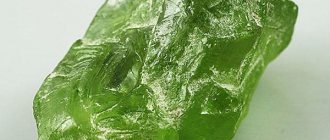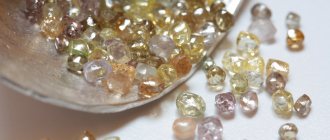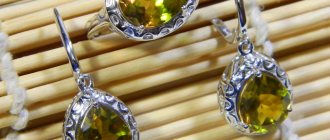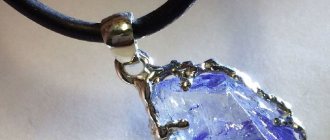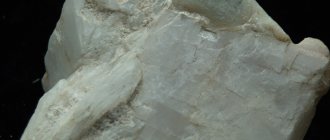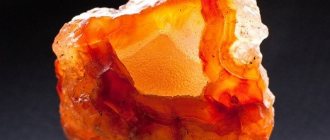Blue sapphire, with a formula that in chemistry denotes any corundum, has all the characteristics of these minerals. History preserves legends and tales about the azure yacht. The modern jewelry world demonstrates the largest examples that are exhibited in museums. The cost of the gemstone is high, but you will find out what is behind it from the article. The physical characteristics discovered by scientists explain the true value of the gem.
Title versions
The origin of the name occupies an important place in the history of sapphire. According to one version, the inhabitants of ancient Babylon called the hard blue stones “spira,” which is similar to the modern name. This word means “scratching” and emphasizes the natural hardness of the mineral, which is second only to diamond in this regard.
The inhabitants of Hellas called all stones of this color “sapphiros”, and the ancient Hindus said that it was “caniprya” - beloved by Saturn. Tamils living in Hindustan, Burma, and Malaysia did not immediately distinguish it from the corundum group. Opaque gray stones became true jewels only after processing. Jews for a long time confused the mineral with lapis lazuli.
A difficult path has been made to the Slavic name for sapphire. The phonetics of Greek, Persian and Arabic languages can be traced here. Thousands of years of vocabulary adaptation turned the mineral into yakhont.
Famous finds
The fate of some world-famous sapphires is amazing. So, for ten years, the “Black Star of Queensland”, like ordinary heavy material, propped up the door of the house so that it would not close from the wind. In 1947, the 733-carat support was recognized as a jewel. Changes of owners began, who earned and spent millions of dollars on this.
The National Museum of Natural History (Washington) has a unique brooch. The 423-carat cushion sapphire, which is framed by 20 diamonds, is named after its owner, Mrs. Logan, who donated it.
Royal dynasties of many countries of the East and West decorated themselves with sapphires. A blue “rose” weighing 167 carats crowns the crown of the British Empire, and the famous Stewards sapphire is inserted into its base.
This stone became Princess Diana's favorite jewelry. Her collection includes an oval-shaped engagement ring with blue Ceylon corundum. But modern rulers are not pioneers. According to legend, sapphires decorated Cleopatra’s crown already in the 1st century BC.
The magical properties of sapphire
This stone can bring out the best qualities in a person. His magic will help preserve love and family. This gem is considered a symbol of friendship, sacrifice, and good attitude towards people.
Rulers of nations wore sapphire on their crowns and around their necks to protect them from envious people and to avoid making mistakes.
It was believed that if the mineral was set in gold, it would help control people.
Magical properties of colored sapphires:
- White will help you achieve your goal. This is an attribute of people who strive for spiritual perfection.
- Yellow will drive away anxiety and attract inspiration to creative people.
- Green is able to bring peace to conflicting families. Selfish natures are made kind and sensitive.
- Blue will help improve your thinking process, activate superpowers, and even open your “third eye.”
- Blue attracts luck, love, and helps with travel.
If the person who used the blue sapphire sells it or gives it to someone, the stone will still protect its owner even from a distance.
- Pink will help you find what the owner dreams of.
- Black - acts as a real wealth magnet. Helps in making the right decisions.
- Star helps to recognize lies and hypocrisy. Retains the properties that it accumulated under the previous owner. In ancient times, stones in which three intersecting rays form a six-pointed star were considered especially powerful magically; they were associated with three great forces: Faith, Hope, Love.
Each of these stones serves only good deeds. If the owner has wicked intentions and actions, he can send the negative to him.
Chemical composition and formula
It is noteworthy that today jewelers call all corundums, except red ones, sapphires. The name rubies stuck to them. The remaining stones make up the sapphire group with the chemical formula Al2O3. These symbols represent aluminum oxide.
The fantasy colors of sapphires are created by impurities - titanium, vanadium and iron. The palette looks like this:
- orange;
- pink-orange (padparadscha);
- pink;
- yellow;
- blue;
- green;
- violet;
- black.
Colorless specimens are called leucosapphires. But among all the varieties, the most valuable are stones of rich cornflower blue color. It is formed by titanium and iron, which make up certain proportions in the crystal.
If titanium is absent, then iron colors the mineral yellow or green. Vanadium produces violet shades. The chemical composition and proportions of impurities present in the stone regulate the color palette.
Durable and solid
Now let's look at the physical properties. Sapphire is characterized by a glassy luster, which is caused by the specular reflection of light from the faceted surface. In particular, there is a dependence on the refractive index; for the azure yacht it ranges from 1.762 to 1.778.
Transparent and opaque stones are found in nature. We mentioned the famous hardness of sapphire above. It remains to name the exact indicator - this is 9 units on the Mohs scale. This value does not allow any other materials to penetrate into the sapphire.
The density of the stone is 4 g per cubic meter. cm speaks of the high strength of sapphire, because these concepts are interrelated. The mineral begins to melt at a temperature of 2040 degrees Celsius. Under normal conditions, such heat is impossible to encounter.
Grinding of the crystal, which is harder than a mineralogical tool, does not occur on the “biscuit”. Therefore, it is believed that sapphire has no trait color, or is called white.
For more information on the topic, read the article “Properties of sapphire stone and who it is suitable for.”
Medicinal properties
For centuries, healers have studied the healing effects of sapphire on humans and are convinced that it can cure or alleviate many ailments. Lithotherapists and traditional healers advise using this stone to treat the following diseases (without deviating from the recommendations of doctors):
- diseases of the heart, kidneys, skin;
- bronchial asthma;
- diabetes mellitus;
- migraine.
Any type of sapphire helps to improve your health, the main thing is that the crystal is natural and without damage.
And yet there is “specialization”, that is, stones of a certain color are more effective for treating specific diseases:
- Yellow will help improve the functioning of the entire body, increase immunity, and relieve stress and depression.
Yellow sapphire has very strong energy, so you need to wear it periodically. If used continuously, a person may experience restlessness and anxiety.
- Blue can help with problems with the heart and blood vessels, headaches, inflammation, and dermatological diseases.
- Green will improve sleep (if you put the mineral under your pillow) and restore visual acuity after short sessions of contemplating the gem.
The healing properties of sapphire set in silver are enhanced.
For washing, compresses and washing of diseased areas of the body, inflammation, wounds, water infused with this mineral is used.
Preparation of healing sapphire water: at dawn, place the stone in the water and after a while it can be used.
Crystal Spread
The sapphire mineral is mined in the USA and Australia, Burma and China, India and Thailand. Usually the crystals are adjacent to pegmatite formations or are found among placers (cemented clastic material). The largest natural mineral the world knows weighs 3,500 carats. In one of the quarries in North Carolina (USA), a local radiologist found it. For several months, the precious find turned into a paperweight.
Russia is not famous for its vast areas of true blue sapphires, but in the Urals there are mines where stones with a gray tint are being mined. A greenish tint is typical for minerals mined on the Kola Peninsula.
Crystallography classifies sapphire as a trigonal system, a crystal lattice with one third-order axis. In structure, the crystal itself belongs to the planaxial point group. The unit cell consists of three vectors of equal length. The angles between them are also equal, but in no case are they right.
Artificial stones
Most synthetic crystals are obtained by the drawing method using a seed base. Fragments of natural stones are used as it. The base substance is heated to the melting point and the base is placed into it. As crystallization progresses, the workpiece is pulled out. The finished crystal is cut into pieces of the required size. Even unique stones with the effect of asterism are obtained artificially.
The main production of synthetic sapphires is located in the following countries:
- Russia;
- USA;
- China;
- Japan.
From a physical and aesthetic point of view, natural and synthetic sapphires are practically no different from each other.
But artificial stones cannot be used as amulets and amulets.
They can be distinguished by the following characteristics:
- Price. If we compare natural and artificial stones that have the same mass, the cost of the latter will be significantly lower than natural materials.
- The quality certificate is the main proof of the origin of the jewelry stone. Failure to provide it is a sign of a low-quality fake.
- There are no foreign particles in artificial sapphires, but there may be small air bubbles.
- In artificial star stones the image is in a static position; on the surface of natural minerals it moves.
- In ultraviolet light, natural stones give off white highlights. Synthetic corundums do not react to ultraviolet radiation.
Description of the crystal lattice
Most often, sapphire crystals are created in nature in the form of a prism or two mirror-connected pyramids (dipyramid). There are also rhombohedrons (a cube with rhombus-shaped faces) and pinacoids (the faces of the pyramids are symmetrical to the center of symmetry). It is noted that the surface of the mineral is often covered with hatching of oblique lines furrowing the surface.
The crystal structure of several rhombohedrons makes up a unit cell. The scheme is considered simple. Oxygen ions are arranged in sheets at an angle of 90 degrees to the triple axis and superimposed on each other. Aluminum cations are located between these plates and fill two-thirds of the void. They are formed by three oxygen anions of one sheet and three of the other, rotated 180 degrees. Each triple lies on a common face of adjacent octahedra.
The alternation of octahedra is perfect, for every unoccupied one there are two occupied ones. In the column this is achieved by strict compliance of oxygen sheets superimposed on each other.
The mistakes of cutters and the wonders of rutile
Natural jewelry sapphires are used to make jewelry and are highly valued. When cutting, it is important to maintain symmetry and proportions. An experienced craftsman always tries to “drive” holes, scratches and chips onto the lower part of the stone (pavilion), which will not be noticeable or will be covered by the frame.
It is not considered correct to “pull” the pavilion; then the shape of the stone becomes like an acorn, and the front part of the jewelry looks small. If you make the proportions the other way around, then nothing good will come of it either. A “window” will appear on the “face” of the stone. The spot stands out in the center, and the area surrounding it does not shine at all (the light does not return to the eye of the beholder).
For blue corundums, any shapes during processing are acceptable - oval, circle, triangle, drop, heart, marquise, quadrangular “cushion”. But if needle-shaped inclusions of rutile (titanium oxide) are formed in the crystal, then the sapphire shows a star. Its radiance is enhanced when the stone is processed into a cabochon.
A twelve-pointed star is created when two rutile needle-shaped formations join together in a stone. Such properties of sapphire are marked by a special name - asterism. Star jewelry is more expensive than regular minerals.
Who suits sapphire according to their zodiac sign?
Astrologers, studying the properties of this mineral, came to the conclusion that it suits almost every zodiac sign.
Ideally compatible with four zodiac signs:
- Sagittarius - men will become more determined and focused on winning; women are attractive and wise.
- Aquarius - his multifaceted inner potential will be released (in spirituality, in business, and even in eloquence).
- Leo and Aries - people born under these signs are characterized by intemperance and hot temper. The gem will reduce their ardor, which creates problems, and teach them to control their behavior. It will also help you find your purpose and achieve success.
Sapphire also has a positive effect
- Geminis will find true friends and useful business connections. For women it acts as a good antidepressant.
- It will bring self-confidence and peace of mind to Scorpio
- Virgo will become more sociable.
- Taurus , if he is responsible, the stone will help in business.
- Cancer , according to the horoscope, will bring health.
This gem does not affect Pisces and Libra - for them it is only a decoration.
Sapphire is contraindicated for Capricorn, who can be depressed and indifferent to everything.
There are many suitable stones for Capricorn, for example, garnet, onyx, spinel (blue).
You should wear sapphire intermittently (especially yellow) and only if it is undamaged - otherwise it will attract major troubles.
for people over 36 years old , since its patron Jupiter will revolve around the Sun three times .
Songea and padparadscha
The only continent where sapphires have never been found is Antarctica. Among the varieties, we note songea, which is distinguished by green or reddish tints. Phenomena of asterism are not uncommon among finds.
A distinctive feature of songea is its rich palette of colors. Despite the small size of the crystals, stones even weighing 2 carats are considered rare; their purity is perfect. We discuss this quality in detail in the article “Classification of Sapphire Purity.”
The extraction of songea is established in Tanzania, and the name of the species was given by the territory where the minerals are distributed. Blue gems are also mined in this country, but in the Tunduru mines. The corundum mined here also bears the same name.
Pink-orange padparadschas are concentrated on the island of Ceylon. Lotus-colored stones are also never too large. Any sapphire weighing 5 carats becomes a collector's item. The New York History Museum houses the famous 100-carat mineral.


